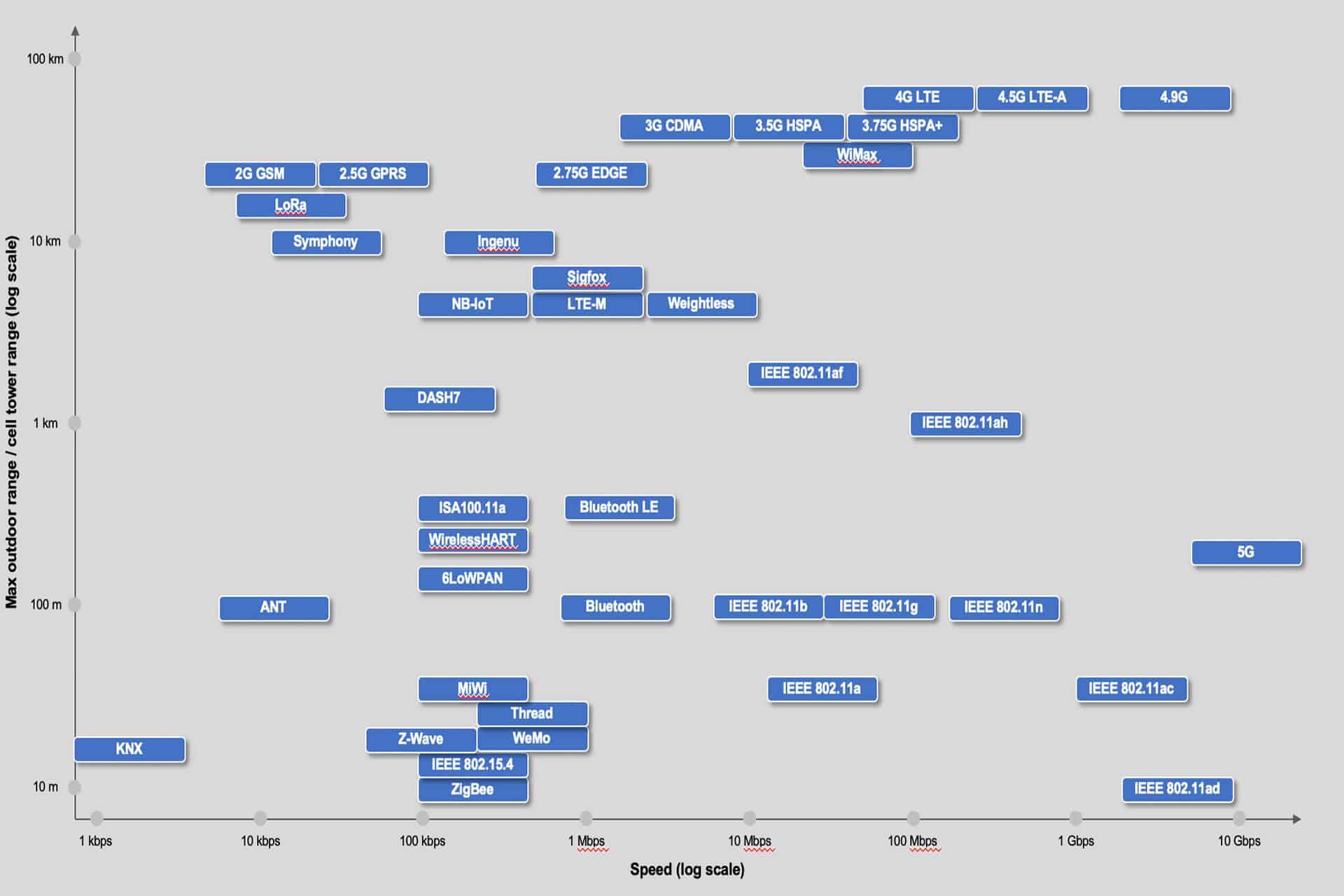IoT Wireless Protocols - Speed & Range
| wdt_ID | Wireless technology / standard | Data Rate | Approximate Range |
|---|---|---|---|
| 1 | 5G | Low-band 5G (600 - 700 MHz) giving download speeds a little higher than 4G at the moment: 30-250 Mbps. Mid-band 5G (2.5-3.7 GHz) currently allowing speeds of 100-900 Mbps. High-band 5G (25 - 39 GHz and higher frequencies up to 80GHz) achieves, at the mom | Range is correlated with frequency bands - low band 5G has similar range to 4G (tens of kilometers), Mid-band 5G has several km range. High-band 5G has hundreds of meters up to 1.5 km range. |
| 2 | ANT+ Alliance | 12.8 Kbit/s - 60kbit/s | ≈ 30m |
| 3 | Bluetooth | ≈ 2Mbps | ≈ 50m |
| 4 | BLE (Bluetooth Low Energy) or Bluetooth Smart (Bluetooth 5, 4.2) | <1Mbps ≈ (n x 100kbps) | ≈ 100m |
| 5 | GSM/GPRS/EDGE (2G), UMTS/HSPA (3G), LTE (4G) | Typical download: 35-170kps (GPRS), 120-384kbps (EDGE), 384Kbps-2Mbps (UMTS), 600kbps-10Mbps (HSPA), 3-10Mbps (LTE) | ≈ 35km max for GSM and ≈ 200km max for HSPA |
| 6 | IEEE 802.15.4 | ≈ 20 kbps and 40 kbps (BPSK ), ≈ 250 kbps (O-QPSK with DSSS) | ≈ 100m |
| 7 | ISA100.11a | ≈ 250 kbps | ≈ 100m |
| 8 | 6LoWPAN | ≈ 250 kbps | ≈ 100m |
| 9 | LoRaWAN | ≈ 0.3-50 kbps | ≈ 15km |
| 10 | EC-GSM-IoT | 70 kbps (GSMK), 240 kbps (8PSK) | ≈ 15km |
| 11 | LTE-MTC Cat 0 | ≈ 1 Mbps | Range is variable and depends on frequency bands, propagation conditions etc. typically it is ≈ 10km |
| 12 | LTE-M (Cat M1, Cat M2 ) - eMTC | LTE-M Cat M1 ≈ 1 Mbps LTE-M Cat M2 ≈ 4 Mbps DL / ≈ 7 Mbps UL | Range is variable and depends on frequency bands, propagation conditions etc. typically it is ≈ 10km |
| 13 | NB-IoT - Narrowband-IoT (LTE Cat NB1 and LTE Cat NB2) | LTE Cat NB1 ≈ 66 kbps (multi-tone) and ≈ 16.9 Kbit/s (single-tone) LTE Cat NB2 ≈ 159kbps | Range is variable and depends on frequency bands, propagation conditions etc. typically it is better than LTE-M coverage. |
| 14 | Neul | up to 100kbps | ≈ 10km |
| 15 | NFC | 106kbps, 212kbps, 424kbps | ≈ 10cm |
| 16 | RPMA (Random Phase Multiple Access) | 100kb | ≈ 70km |
| 17 | IEEE 802.11a/b/g/n/ac | Different data rates are enabled in IEEE 802.11 family of standards and their theoretical throughput is 11 Mbps ( IEEE 802.11b), 54 Mbps (IEEE 802.11a and IEEE 802.11g), 100 Mbps (IEEE 802.11n) or 300 Mbps (IEEE 802.11ac). | ≈ 50m |
| 18 | IEEE 802.11ah (Wi-Fi HaLow ) | 347Mbps | ≈ 900m |
| 19 | IEEE 802.16 (WiMax) | 40Mbit/s - mobile, 1 Gbit/s - fixed | ≈ 50km |
| 20 | HART | 250 kbps | ≈ 200m |
| 21 | Z-Wave | 40kbps (915MHz) and 20kbps (868MHz) | 30-100m |
| 22 | ZigBee | 250 kbps (2.4GHz) 40kbps (915MHz) 20kbps (868MHz) | 30-100m |
| 23 | Thread | 250kbps | ≈ 30m |
| 24 | DigiMesh | 250 kbps (2.4) 40kbps (915) 20kbps (868) | ≈ 100m |
| 25 | MiWi | 20kbps | ≈ 300m |
| 26 | EnOcean | 125kbps | ≈ 30m (outdoor 300m) |
| 27 | Weightless (W, N, P) | ≈ 600bps-100kbps | ≈ 2km (P), 5km (W, N) |
| 28 | mcThings | 50kbps | ≈ 200m |
| 29 | LoRa | 50kbps | ≈ 30km |
| 30 | SIGFOX | 600bps | ≈ 40km |
| 31 | DECT ULE | 1Mbps | ≈ 300m |
| 32 | Insteon | 38400bps - via RF 13165bps - via powerlines | ≈ 50m |
| 33 | RFID | 4kbps - 640kbps (depending on the active or passive type of device and frequency range). | 0.01m-10m (depending on the frequency range) |
| 34 | WAVIoT (NB-Fi - Narrowband Fidelity) | 10-100bps | ≈ 50km |
| 35 | DASH7 Alliance Protocol (D7A or D7AP) | 167kbps | ≈ 2km |
| 36 | Wi-SUN | 300kbps | ≈ 1000m |
| 37 | Wavenis | 9.6kbps (433 & 868MHz) / 19.2kbps (915MHz) | ≈ 1000m |
| 38 | MiOTY | 407 bps | ≈ 20km |
| Wireless technology / standard | Data Rate | Approximate Range |
Marin Ivezic
For over 30 years, Marin Ivezic has been protecting critical infrastructure and financial services against cyber, financial crime and regulatory risks posed by complex and emerging technologies.
He held multiple interim CISO and technology leadership roles in Global 2000 companies.















































